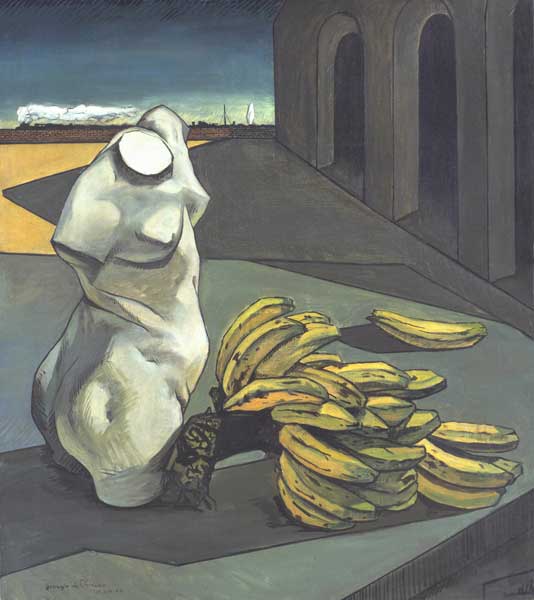Great Works: The Uncertainty of the Poet, 1913 (106 x 94cm) Giorgio de Chirico
Tate Modern, London

The visually seductive, topsy-turvy world of unreason is meticulously rendered in this painting by Giorgio de Chirico. Derangement has seldom been so crisply and so patiently expressed. This painting has such a studied air, as if the young painter – he was 25 years old when he made it – has been observing the scene, with its ominously dark, raking, bizarrely squared-off shadows and ever receding horizon, dryly and minutely. There is such a painstaking attention to the issue of perspective, for example. Those flat planes of colour – the huge green plinth, the yellow (and what a shockingly bright Dijon-mustardy-yellow it is!) and the grey, are all laid down with such loving care, albeit somewhat flatly and brutally and definitively, as if they are so many bricks dropped on to an unsuspecting toe. I say issue of perspective quite deliberately, quite finically, because none of this makes any real sense. It all falls to pieces in the end. It is all a kind of not-so-gentle mockery of the idea of planes and perspective and all those painstaking attendant mathematical certitudes. It is all flats and stage-sets really, lighter-than-air façades, behind which there perhaps exists an amplitude of... nothing at all – just as there is nothing but a yawning blackness behind and beyond those yawning arcades.
Take those arches, for example. Look at the sharp edge of the vertical wall beyond the third arcade, right at the bottom, where it seems to butt up against that long and so meticulously painted low brick wall. Where exactly do they exist in relation to each other, this building and this wall? It is impossible to tell. They seem to have been manoeuvred into position with the aid of strong men and some mechanical gear. At first glance, they seem to be nudging up against each other, but when our eye rises to take in the train hurtling from left to right (we are lucky to catch it before it steams headlong out of the painting) with its fanfarish gouts of streaming smoke – that train which seems to be speeding along the top of the wall – or perhaps it is being held aloft by some viaduct immediately behind the wall – we recognise that the train, surely, is much further away from us than the end of the arcade. There is no way in which they could be close to each other. Or are we wrong about that?
But what of the foreground? What has the foreground to do with the speeding train or, to the far right of it, that white ship's sail – if that is indeed what it is – which seems to rise up from nowhere like a flaming white plume? (Yes, we conclude, when we spot that sail, that perhaps there is a sea or a river behind the viaduct which may or may not be behind that wall after all.) What has a ship's sail and a speeding train to do with a headless, armless, legless classical statue, which is making a tragic twist in our direction, as if exhorting us to acknowledge her grief?
But wait a minute. There is something else here. There is the largest bunch of over-ripe bananas which has ever been seen in a painting in the Western tradition in the company of a headless classical statue and a speeding train and the small flaunt of a ship's sail. Are these bananas some kind of gross penile joke? Are they not too big for their own skins? Why should bananas be allowed to strike such a pose beside an example of classical statuary? The fact that the classical statue – a note tells us that it is Aphrodite, she who once emerged from the froth of the ocean – is set in conjunction with a bunch of bananas transforms this section of the painting into a kind of still life. (Yes, we have often seen, and especially in the Renaissance, paintings of brimming bowls of fruit and flowers beside statues of the pagan gods.) And yet the whole point of a still life, surely, is that the elements are perfectly still, whereas we are not entirely sure that this particular statue is quite still enough. In spite of the fact that it has lost its head, it looks altogether too fleshy, and too much in twisty motion, for us to be entirely convinced that it is made of stone. If we pricked that buttock, would it bleed?
Yes, the entire painterly escapade is utterly preposterous, which is what the poet Wendy Cope evidently decided when she wrote her own poem entitled "The Uncertainty of the Poet" in mock-homage to this painting. This is how that poem begins: "I am a poet./I am very fond of bananas/ I am bananas./I am very fond of a poet."
Ah yes indeed(y).
ABOUT THE ARTIST
Giorgio de Chirico (1888-1974) has long been regarded as one of the Founding Fathers of Surrealism, which had not yet been brought to birth by the cantankerous André Breton when this painting was made. In later life, De Chirico returned to a mode of classicism, and disowned much of his earlier work as the antics of a juvenile.
Join our commenting forum
Join thought-provoking conversations, follow other Independent readers and see their replies
Comments